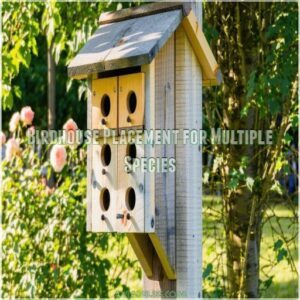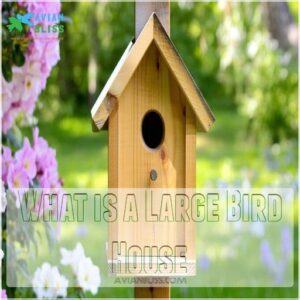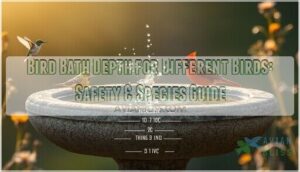This site is supported by our readers. We may earn a commission, at no cost to you, if you purchase through links.
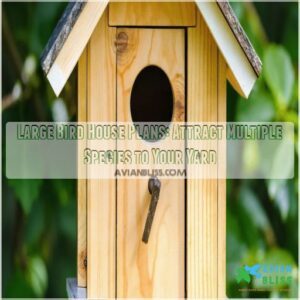
By considering the unique needs of bluebirds, woodpeckers, wrens, and even wood ducks, you can design a spacious dwelling that’ll attract a vibrant avian community to your backyard.
Choose the right location, incorporate essential features like predator protection, and voila – you’ve got a bird-approved castle that’ll have your winged neighbors flocking to move in.
With a little creativity and care, you can transform your outdoor space into a lively hub for all sorts of beautiful birds.
Get ready for a birding bonanza in your own backyard!
Table Of Contents
- Key Takeaways
- Birdhouse Placement for Multiple Species
- What is a Large Bird House
- Birdhouse Requirements for Specific Species
- Top 4 Large Bird Houses for Multiple Species
- Tips for Attracting Multiple Species to a Large Bird House
- Frequently Asked Questions (FAQs)
- Where can I buy a large mounted bird house?
- How big is a birdhouse?
- How many holes does a birdhouse have?
- Do you need a small bird house?
- How do I choose a bird house plan?
- Do birdhouses have a rough exterior?
- What is a large bird house called?
- Are there different bird houses for different birds?
- Can you put multiple bird houses together?
- Which birdhouses attract which birds?
- How do I clean and maintain a large birdhouse?
- What are the ideal placement guidelines for a large birdhouse?
- What type of wood is best for constructing a large birdhouse?
- How can I ensure a large birdhouse is predator-proof?
- What are the recommended dimensions for a large birdhouse?
- Conclusion
Key Takeaways
Here are 4 key takeaways from the article on "large bird house for multiple species":
- Choose the right birdhouse size, entrance hole, and features to accommodate the birds you want to attract – from wrens and bluebirds to woodpeckers and owls.
- Strategically place your large birdhouse in an open area with nearby food, water, and shelter to create an inviting bird-friendly oasis.
- Regularly clean and maintain your birdhouse to keep it in tip-top shape and prevent disease – just use a 10% bleach solution and let it fully dry.
- Add natural nesting materials like soft fibers and twigs to make your large birdhouse extra appealing and cozy for your feathered friends.
Birdhouse Placement for Multiple Species
Placing your large birdhouse in the right spot is key to attracting a variety of feathered friends.
Consider the habitat, food sources, and protection from predators to give your backyard birds the perfect new home.
Choosing The Right Location
Placing a birdhouse is a bit like real estate: it’s all about location, location, location.
Consider exploring different birdhouse location ideas to find the perfect spot, such as near a food source or sheltered area birdhouse placement tips.
Choose a height that suits the bird species you want.
Consider tree type and surrounding areas to avoid nearby hazards.
Water access can be a bonus.
A good birdhouse location and size mean more bird species diversity and successful nesting.
Habitats and Food Sources
Picture your yard as a bustling bird oasis: a combo of native plants and fresh water sources can attract a variety of birds.
Offer seed feeders for added bird diversity, and let insect control be their natural food source.
Nesting materials nearby make it all the more inviting.
Creating a bird-friendly yard really soars when you cater to their tastes.
Predator Protection and Safety
To safeguard your feathered friends, it’s important to predator-proof your birdhouse. First, install a sturdy baffle to keep curious cats at bay. Next, choose a location away from trees and power lines to deter snakes and owls. Secure the house tightly and monitor regularly to make sure your birds’ safety and peace of mind.
- Use a predator-proof baffle to deter cats and other climbing predators.
- Position the birdhouse in an open area away from trees and structures.
- Avoid placing the birdhouse near power lines or other potential perches for predators.
- Regularly inspect the birdhouse for any signs of tampering or predator access.
What is a Large Bird House
If you want to attract a diverse array of feathered friends to your backyard, a large bird house can be a game-changer.
Unlike their smaller counterparts, these spacious abodes offer ample room for multiple species to take up residence, fostering a vibrant, lively environment.
At their core, large bird houses are designed with both size and comfort in mind, providing a safe and inviting haven for a wide range of avian tenants.
To make sure the right entrance hole size for specific bird species, consider referring to DIY Birdhouse Plans, which can make a significant difference in attracting the desired birds.
| Birdhouse Size | Suitable Species |
|---|---|
| 10"x8"x8" | Wrens, Sparrows, Finches |
| 24"x15"x15" | Bluebirds, Cardinals, Purple Martins |
| 34"x15"x15" | Owls, Hawks, Falcons |
With their generous proportions and thoughtful amenities, large bird houses open up a world of possibilities for backyard birding enthusiasts, allowing them to welcome an enchanting array of feathered friends to their little slice of nature.
Birdhouse Requirements for Specific Species
Ensuring your large birdhouse attracts a variety of feathered friends takes some planning.
From the perfect size hole and height for wrens to the ideal placement and color for bluebirds, we’ve got the specifics you need to welcome new avian neighbors.
Bluebirds and Swallows
Thinking about large birdhouses, bluebirds and swallows each have unique nesting habits.
Bluebirds love open fields and swallows prefer water nearby.
Here’s how to make them your feathered neighbors:
- Size matters – Bluebirds need a 1.5-inch entry; swallows? Slightly bigger.
- Location is key – Open spaces for bluebirds, water for swallows.
- Secure setup – Tall and sturdy for a safe haven.
Woodpeckers and Chickadees
Bluebirds and swallows share your garden, but don’t forget woodpeckers and chickadees craving a snug birdhouse.
Woodpeckers enjoy roomy nests with a 2" hole, while chickadees prefer cozy boxes with a 1-1/4" entrance.
Both appreciate earth-toned hideaways that offer safety—like cozy cabins protecting them from the wild winter winds.
With the right size, you’ll see less competition for space.
Wrens and Robins
For charming wrens and friendly robins, choose a birdhouse with a 1-1/8" or 6" wide open front nestbox.
Place it 5-10 feet high, near natural cover and food sources like berry bushes. Wrens prefer an earth-tone hue, while robins appreciate a more natural look.
You can find a variety of birdhouse designs specifically for wrens and robins, such as those at this Wren Robin House.
- Wrens thrive in sheltered, enclosed spaces
- Robins feel safest with a partial enclosure
- Position the birdhouse near shrubs and trees
- Use natural wood or earth-tone paints
Wood Ducks and Screech-owls
Looking to attract a diverse array of avian visitors to your backyard?
Consider installing a larger birdhouse designed with wood ducks and screech-owls in mind.
These majestic species have unique nesting needs, preferring higher elevations near water.
Tailor your birdhouse with a 10"x10"x24" size, an elliptical 4"x3" entrance, and plenty of wood shavings inside.
Make it a haven for your feathered friends!
Top 4 Large Bird Houses for Multiple Species
Looking to attract a variety of feathered friends to your yard?
Check out our top 4 large birdhouse picks that cater to multiple bird species.
From rustic wood to modern resin designs, these spacious homes will have your backyard buzzing with activity in no time.
1. Resin Bird House Garden Decor
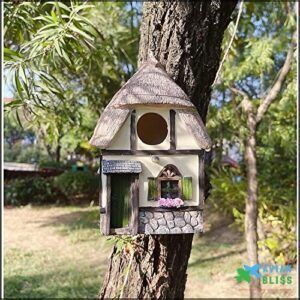
In garden decor, the Resin Bird House stands out with its eco-friendly charm and vibrant palette.
This hand-painted beauty isn’t just eye-catching; it attracts bluebirds, hummingbirds, and swallows.
You can find more large bird house options here at Chewy.
Tucked away safely against predators and harsh weather, it serves as a cozy refuge for our feathered friends.
However, some users find its resin scent a tad overpowering, and note that it doesn’t always lure birds as promised.
Yet, as a Christmas gift, it’s a unique choice for bird lovers.
Best For: This birdhouse is best for nature and bird lovers looking for a colorful and decorative addition to their garden.
- Eco-friendly resin construction
- Hand-painted design with vibrant colors
- Provides shelter for birds against harsh weather and predators
- Some users report a strong resin odor
- May not be as effective at attracting birds as advertised
- Some users report a longer chain than the birdhouse
2. DIY Wooden Birdhouse Kit
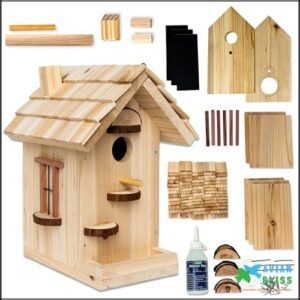
The DIY Wooden Birdhouse Kit from SparkJump offers a fun and rewarding hands-on project for all ages.
Crafted from premium cedar wood, this kit includes everything you need to build a charming birdhouse, perfect for attracting feathered friends to your yard.
With detailed instructions and pre-cut pieces, the assembly process is straightforward, allowing you to express your creativity.
Though some customers have reported minor issues with fit and finish, overall, this kit provides an engaging opportunity to connect with nature and add a delightful touch to your outdoor space.
Best For: This kit is best for anyone looking for a fun and rewarding DIY project, regardless of age or experience level.
- Includes all the necessary materials for a complete birdhouse building experience.
- Crafted from premium cedar wood, ensuring a durable and attractive finished product.
- Offers a chance for bonding and skill-building, making it ideal for family projects.
- Some customers reported issues with warped wood and pieces fitting together properly.
- Glue may take longer than stated to set.
- Instructions may be vague in some areas.
3. Green Distressed Wood Birdhouse
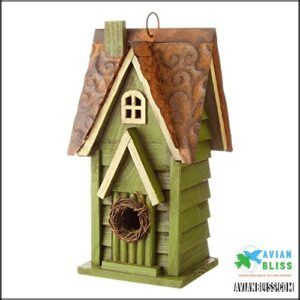
This charming Green Distressed Wood Birdhouse, from Glitzhome, adds a touch of rustic elegance to your garden.
Measuring 6.5"D x 5.5"W x 12"H, it’s a cozy home for smaller birds.
Its distressed wood and metal accents give it a vintage look.
Easy hanging is a plus, but the small entrance mightn’t suit all species.
Remember, birds are picky!
While it’s cute and durable, consider its size limitations before purchasing.
A cleaning door is a handy feature for maintenance, making sure a healthy habitat.
Best For: This birdhouse is best for those looking for a decorative and charming home for smaller birds.
- Distressed wood and metal accents give it a vintage look.
- Easy hanging with a hanging ring.
- Cleaning door for easy maintenance.
- Small entrance may not be suitable for larger birds.
- Size limitations may not be ideal for breeding.
- Some customers reported difficulty hanging the birdhouse straight.
4. Cedar Wren House Birdhouse

One remarkable option is the Cedar Wren House Birdhouse.
Made from premium cedar and with rust-free stainless-steel hardware, this birdhouse boasts air vents for excellent ventilation – ensuring the health and comfort of its avian residents.
With a 1 1/8" entrance hole, it’s designed to attract wrens and chickadees while deterring larger, more dominant species.
Plus, the clean-out doors make annual maintenance a breeze.
Customers rave about its sturdy construction and effectiveness in drawing in the desired feathered friends.
Whether mounted on a pole or hung from a tree, this cedar wonder is a must-have for any bird-loving backyard.
Best For: Bird lovers looking for a durable, well-made birdhouse that attracts wrens and chickadees.
- Made with premium cedar and rust-free stainless-steel hardware.
- Features air vents for excellent ventilation.
- Clean-out doors make maintenance easy.
- May need to be cleaned out before the next year for continued use.
- May need to be protected from squirrels and other animals.
- May be too late in the year to be used by birds.
Tips for Attracting Multiple Species to a Large Bird House
Don’t settle for a one-size-fits-all birdhouse! Customize your large bird house to attract a diverse array of feathered friends by considering their unique size, habitat, and nesting needs.
Birdhouse Size and Comfort Features
Choosing the right birdhouse size is key to attracting multiple species.
Look for a home that provides ample space, with features like:
- Spacious interior dimensions for comfort
- Proper entrance hole size to suit your target birds
- Perch placement that encourages nesting
- Ventilation and drainage to keep the home cozy
- Nesting materials like wood shavings or natural fibers
Maintenance and Cleaning
Regular cleaning is key to maintaining a healthy birdhouse. Aim to clean it annually after breeding season ends. Use a 10% bleach solution to scrub away debris and disinfect – this prevents diseases and parasites.
For more bird house cleaning tips, including proper placement to deter predators, refer to birdhouse cleaning techniques.
Make sure to let the house fully dry in the sun afterwards. Wearing gloves and a mask will protect you during the process.
| Cleaning Schedule | Cleaning Supplies | Why Clean |
|---|---|---|
| Annually after breeding season | 10% bleach solution | Prevent disease spread |
| Scrub all corners and crevices | Gloves and mask | Kill parasites |
| Allow to fully dry in sunlight | Encourage birds to return |
Providing Natural Nesting Materials
Providing natural nesting materials can enhance the appeal of your large bird house to a variety of avian species.
Offer a mix of soft fibers, dried grasses, and twigs to cater to different nesting preferences.
Avoid using synthetic materials that could harm delicate hatchlings.
With the right resources, you’ll create an inviting habitat that birds will love to call home.
Frequently Asked Questions (FAQs)
Where can I buy a large mounted bird house?
Discover the perfect avian hideaway at your local home improvement store or online retailer, where an array of jumbo birdhouses await to transform your yard into a feathered paradise.
How big is a birdhouse?
Birdhouse size depends on the bird species you want to attract.
Small birds like wrens need a 4x4x8 inch house, while medium birds like bluebirds prefer a 5×5×10 inch one.
The right fit makes birds feel right at home.
How many holes does a birdhouse have?
Hold up, you’re probably wondering how many holes a birdhouse needs, right?
Well, the sweet spot is usually just one – a single entrance hole is enough to attract a wide variety of feathered friends.
Do you need a small bird house?
No, you don’t necessarily need a small birdhouse.
Many bird species, like bluebirds and chickadees, actually prefer medium-sized homes.
The key is choosing a house that matches the size of your feathered friends.
How do I choose a bird house plan?
When choosing a bird house plan, consider the size of your feathered guests and their nesting preferences.
Bird house features like proper ventilation, drainage, and predator-deterring baffles to make your backyard haven irresistible.
Do birdhouses have a rough exterior?
Birdhouses often have a rougher exterior texture to mimic natural nesting cavities, which birds find more appealing.
The textured surface provides traction for perching and can even help insulate the house.
What is a large bird house called?
A large birdhouse designed to accommodate multiple bird species is often referred to as a "multi-family" or "multi-unit" birdhouse.
These spacious abodes provide ample nesting space for a variety of cavity-dwelling birds.
Are there different bird houses for different birds?
Hey there, friend! You bet – different birds have different housing preferences.
Wrens and bluebirds, for instance, need smaller digs than big ol’ purple martins.
Gotta match the birdhouse to the bird, ya know? Easy peasy!
Can you put multiple bird houses together?
Many bird species actually prefer housing communities. Just be sure to space them out and choose compatible species. This gives birds more options and helps prevent territorial conflicts.
Which birdhouses attract which birds?
Different birdhouses attract different species.
Wrens and bluebirds need specific dimensions, while woodpeckers and owls have their own preferences.
Consider the birds you’d like to invite and choose a house suited to their needs.
How do I clean and maintain a large birdhouse?
To maintain a birdhouse, give it a good scrub at the end of breeding season using a 10% bleach solution. This’ll keep it spic and span for next year’s tenants.
What are the ideal placement guidelines for a large birdhouse?
As the bluebird of happiness, your large birdhouse should soar high atop a pole, basking in the glory of an open field.
Face it east to catch the morning sun and watch your feathered friends flutter in.
What type of wood is best for constructing a large birdhouse?
Untreated cedar or pine work best for building birdhouses. These woods are durable, insulate well, and won’t splinter – perfect for creating a cozy, safe home for your feathered friends.
How can I ensure a large birdhouse is predator-proof?
Did you know a whopping 80% of nesting birds don’t survive to adulthood due to predators?
To keep your backyard birds safe, make sure your birdhouse has a sturdy baffle that blocks snakes, raccoons, and cats from reaching the nest.
What are the recommended dimensions for a large birdhouse?
For a large birdhouse, aim for dimensions of 24"x15"x15" – perfect for accommodating medium-sized birds like bluebirds, cardinals, and even purple martins.
This size provides ample space and comfort for your feathered friends.
Conclusion
Your backyard may now resemble a five-star resort for winged guests, but the real prize is witnessing the beautiful diversity of birds that’ll flock to your lavish large bird house.
By catering to multiple species’ needs, you’ll transform your outdoor space into an enchanting avian oasis that’ll have you chirping with delight.
So why not get started on crafting the ultimate luxury lodgings for your feathered friends?

